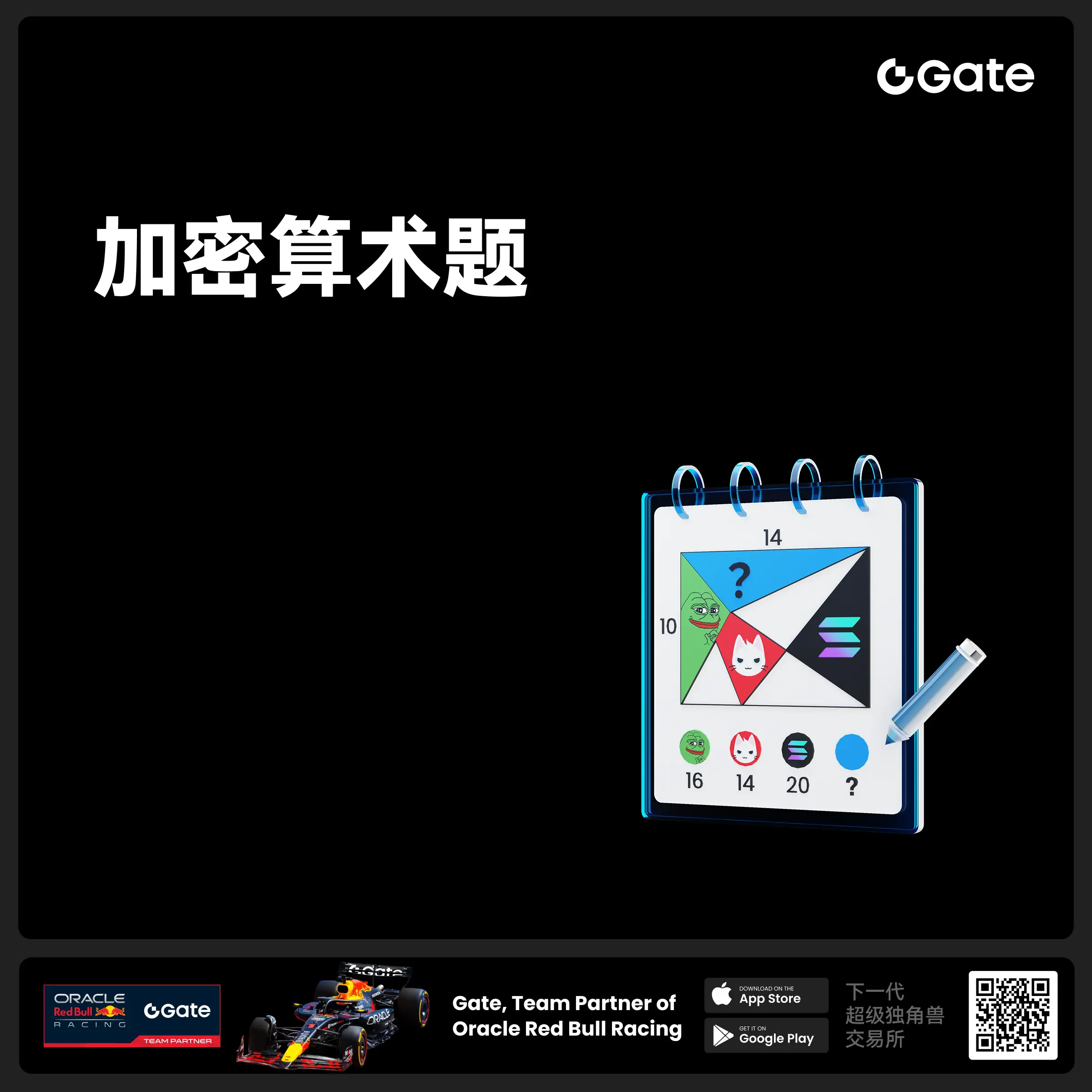更多
- 话题1/3
24768 热度
9198 热度
22054 热度
29023 热度
16049 热度
- 置顶
- 🎉Gate 2025 上半年社区盛典:内容达人评选投票火热进行中 🎉
🏆 谁将成为前十位 #Gate广场# 内容达人?
投票现已开启,选出你的心头好
🎁赢取 iPhone 16 Pro Max、限量周边等好礼!
📅投票截止:8 月 15 日 10:00(UTC+8)
立即投票: https://www.gate.com/activities/community-vote
活动详情: https://www.gate.com/announcements/article/45974
- 📢 #Gate广场征文活动第二期# 正式启动!
分享你对 $ERA 项目的独特观点,推广ERA上线活动, 700 $ERA 等你来赢!
💰 奖励:
一等奖(1名): 100枚 $ERA
二等奖(5名): 每人 60 枚 $ERA
三等奖(10名): 每人 30 枚 $ERA
👉 参与方式:
1.在 Gate广场发布你对 ERA 项目的独到见解贴文
2.在贴文中添加标签: #Gate广场征文活动第二期# ,贴文字数不低于300字
3.将你的文章或观点同步到X,加上标签:Gate Square 和 ERA
4.征文内容涵盖但不限于以下创作方向:
ERA 项目亮点:作为区块链基础设施公司,ERA 拥有哪些核心优势?
ERA 代币经济模型:如何保障代币的长期价值及生态可持续发展?
参与并推广 Gate x Caldera (ERA) 生态周活动。点击查看活动详情:https://www.gate.com/announcements/article/46169。
欢迎围绕上述主题,或从其他独特视角提出您的见解与建议。
⚠️ 活动要求:
原创内容,至少 300 字, 重复或抄袭内容将被淘汰。
不得使用 #Gate广场征文活动第二期# 和 #ERA# 以外的任何标签。
每篇文章必须获得 至少3个互动,否则无法获得奖励
鼓励图文并茂、深度分析,观点独到。
⏰ 活动时间:2025年7月20日 17
- 🧠 #GateGiveaway# - 加密算术题挑战!
你能解出这道加密题吗?
💰 $10 合约体验券 * 4 位获奖者
参与方式:
1️⃣ 关注 Gate广场_Official
2️⃣ 点赞此条动态贴文
3️⃣ 在评论中留下你的答案
📅 截止时间:7 月 22 日 12:00(UTC+8)
- 📢 ETH冲击4800?我有话说!快来“Gate广场”秀操作,0.1 ETH大奖等你拿!
牛市预言家,可能下一个就是你!想让你的观点成为广场热搜、赢下ETH大奖?现在就是机会!
💰️ 广场5位优质发帖用户+X浏览量前5发帖用户,瓜分0.1 ETH!
🎮 活动怎么玩,0门槛瓜分ETH!
1.话题不服来辩!
带 #ETH冲击4800# 和 #ETH# 在 广场 或 K线ETH下 围绕一下主题展开讨论:
-ETH是否有望突破4800?
-你看好ETH的原因是什么?
-你的ETH持仓策略是?
-ETH能否引领下一轮牛市?
2. X平台同步嗨
在X平台发帖讨论,记得带 #GateSquare# 和 #ETH冲击4800# 标签!
把你X返链接提交以下表单以瓜分大奖:https://www.gate.com/questionnaire/6896
✨发帖要求:
-内容须原创,字数不少于100字,且带活动指定标签
-配图、行情截图、分析看法加分,图文并茂更易精选
-禁止AI写手和灌水刷屏,一旦发现取消奖励资格
-观点鲜明、逻辑清晰,越有料越好!
关注ETH风向,创造观点价值,从广场发帖开始!下一个牛市“预言家”,可能就是你!🦾🏆
⏰ 活动时间:2025年7月18日 16:00 - 2025年7月28日 23:59(UTC+8)
【立即发帖】 展现你的真知灼见,赢取属于你的ETH大奖!
- 🎉【Gate 3000万纪念】晒出我的Gate时刻,解锁限量好礼!
Gate用户突破3000万!这不仅是数字,更是我们共同的故事。
还记得第一次开通账号的激动,抢购成功的喜悦,或陪伴你的Gate周边吗?
📸 参与 #我的Gate时刻# ,在Gate广场晒出你的故事,一起见证下一个3000万!
✅ 参与方式:
1️⃣ 带话题 #我的Gate时刻# ,发布包含Gate元素的照片或视频
2️⃣ 搭配你的Gate故事、祝福或感言更佳
3️⃣ 分享至Twitter(X)可参与浏览量前10额外奖励
推特回链请填表单:https://www.gate.com/questionnaire/6872
🎁 独家奖励:
🏆 创意大奖(3名):Gate × F1红牛联名赛车模型一辆
👕 共创纪念奖(10名): 国际米兰同款球员卫衣
🥇 参与奖(50名):Gate 品牌抱枕
📣 分享奖(10名):Twitter前10浏览量,送Gate × 国米小夜灯!
*海外用户红牛联名赛车折合为 $200 合约体验券,国米同款球衣折合为 $50 合约体验券,国米小夜灯折合为 $30 合约体验券,品牌抱枕折合为 $20 合约体验券发放
🧠 创意提示:不限元素内容风格,晒图带有如Gate logo、Gate色彩、周边产品、GT图案、活动纪念品、活动现场图等均可参与!
活动截止于7月25日 24:00 UTC+8
3
From Bank to Broker to Crypto: Infrastructure Playbooks for Regulated Companies Entering Digital Assets
As a result, banks, brokers, and fintech platforms are planning to launch crypto services. This can include custody, trading, or stablecoin rails.
But these companies work under strict rules. They need infrastructure that meets high standards for uptime, access control, compliance, and reporting. A simple API or SDK is not enough. What they need is a full infrastructure strategy.
This article outlines how regulated companies can add crypto services without increasing their risk.
Why regulated companies are moving into crypto
There are several reasons why traditional financial companies are building crypto services now:
The goals are different from startups. Regulated firms need long-term infrastructure that can handle audits, reporting, and operations at scale.
Common entry points for crypto integration
Regulated companies usually begin their crypto journey by focusing on one or two specific services, depending on their market and compliance readiness. One common starting point is custody. Firms that offer custody focus on secure wallet infrastructure, enabling users to deposit and withdraw assets safely. This creates a foundation for other services, such as staking or tokenized investments.
Some companies prioritize trading access. These platforms allow users to buy and sell cryptocurrencies but avoid handling custody by keeping the assets off-chain or locked within internal systems. This limits their exposure to custody-related risks while still meeting customer demand.
Another growing use case is stablecoin integration. Payment firms and cross-border platforms are using assets like USDC or EURC to provide faster and more cost-effective alternatives to traditional rails like SWIFT or SEPA. Others are entering crypto through tokenized asset offerings, where banks and brokers begin experimenting with digital versions of bonds or private equity instruments.
Each approach requires a tailored infrastructure stack and a different level of compliance maturity. But all of them depend on having reliable custody, transaction logic, and audit controls from the beginning.
Core infrastructure requirements
When a regulated company adds crypto to its platform, the infrastructure must meet the same operational and legal standards as any other financial system. Custody systems should be built on secure methods like MPC or HSM, and must include fine-grained control over who can initiate and approve transactions. Access needs to be managed by role, with multi-level approvals and detailed permissions.
Logging and audit trails must be available in real time. Every transaction, user action, or system change needs to be tracked and stored securely, with full export capabilities for regulators or internal teams. Uptime is also critical. Crypto services should match the reliability of traditional trading or banking infrastructure, which means deploying redundancy, health checks, and fallback systems to minimize service interruptions.
Beyond the backend, companies also need tools for real-time monitoring. Dashboards that track delays, performance, or anomalies help operations teams respond quickly. And when working with infrastructure vendors, transparency is essential. Regulated companies need visibility into how the platform works, what its performance history looks like, and how it supports ongoing compliance.
Compliance is a technical requirement
Many crypto compliance rules are enforced through software. Regulated companies must understand the infrastructure requirements behind these rules.
Travel Rule
When users send crypto to external wallets, the system needs to detect when to apply the Travel Rule. This means adding metadata, identifying the receiving service, and preventing non-compliant transfers.
MiCA enforcement
MiCA asks for clear control over custody, user asset management, and risk policies. These controls must be built into the infrastructure. Manual policies are not enough.
Regional requirements
Some regions require local data storage or restrict where wallets can be accessed from. This must be supported in system design and deployment.
At Scalable Solutions, we build compliance into the platform. Features like transaction screening, withdrawal checks, and audit logs are not optional add-ons. They are part of the standard architecture.
What to build in-house and what to use from vendors
Companies that want to offer crypto services need to decide which parts of the infrastructure they will build themselves and which parts they will source from vendors. In most cases, it makes sense to keep control over the user interface, onboarding experience, internal dashboards, and risk or compliance rules that are specific to their business
At the same time, core infrastructure such as key custody, blockchain node access, transaction screening, and monitoring tools can be more efficient and secure when provided by specialized vendors. The key is to work with providers who offer transparency, regulatory readiness, and clear service-level commitments. Systems that don’t provide access to logs, lack proper client separation, or operate as black boxes can create serious operational and compliance risks.
When choosing a vendor, companies should avoid platforms that:
Lessons from the field
What didn’t work
A European broker launched a crypto service using a basic white-label backend. The system gave internal staff access to wallets without proper role separation. When regulators asked for logs, the company couldn’t provide them. The service was shut down after a few months.
What worked
A payment platform added USDC payouts using vendor-based custody and compliance modules. They kept control over AML policy logic and used modular infrastructure. The service launched quickly and passed a regulatory audit within six months.
Conclusion
For regulated companies, crypto is no longer out of reach. But it must be added with the same care as any other financial service.
The infrastructure must support controlled key management, transaction screening, role-based access, logging and audit tools and regional deployment strategies - all in one, simply manageable source.